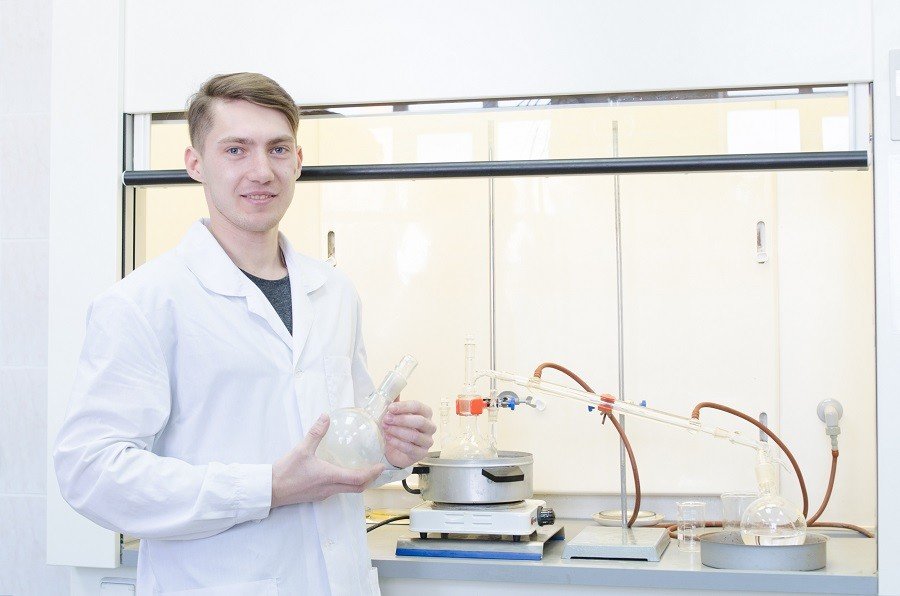South Ural State University is successfully supporting gifted students. All winners of the On to Discoveries contest held at SUSU under Project 5-100 earned grants for completion of their research projects. One of those winners was Andrey Efremov, a student of the SUSU Institute of Natural Sciences and Mathematics.
Research on Antimony Compounds
Andrey Efremov, under the guidance of Olga Sharutina, Doctor of Sciences (Chemistry) and Professor, is working on the synthesis and study of the structure of dicarboxylate triarylantimony. At present, organic antimony compounds are of great interest, as organic compounds of pentavalent antimony find wide use in various fields. For example, dicarboxylates and dioximate triphenylantimony have high biological activity. In particular, they have anti-tumor effect.
“The main idea of this project was to develop reliable methods for synthesis which make it possible to obtain dicarboxylate triarylantimony with high output and high purity, and these can be used in the future for pharmacology, for example, in creating anti-tumor medications,” says Andrey Efremov.
.jpg)
New Method of Synthesis
Scientific literature features publications which confirm biological activity of dicarboxylates and dioximate triphenylantimony. However, other synthesis methods used by different authors studying these compounds include several stages, an additional stage for separating the final product and clearing it of impurities.
“We are suggesting a single-stage method of synthesis for dicarboxylate triarylantimony which contains new organic radicals by means of oxidative additives, characterized by high output yield and purity of product,” explains the SUSU student.
This project is being realized at the Laboratory of Organoelemental Synthesis and the Laboratory of X-ray Diffraction Analysis of the Nanotechnologies REC. The laboratories are fitted with all the necessary equipment for synthesis and studying of new compounds. The created compounds can potentially show biological activity and be used in relevant research laboratories in Russia and abroad.
“Determining the specifics of structure of the synthesized compounds will deepen theoretical understanding on the nature of chemical bonds and intermolecular interactions, and broaden the diversity of structures registered in the international Cambridge Crystallographic Data Center (CCDC),” believes Andrey Efremov.
The difficulty of this work is that in order to determine a structure, it is necessary to obtain a monocrystal which can then be studied using the X-ray diffraction method of analysis. The problem is that not all compounds crystallize. It is necessary to correctly choose solvents, oxidizing agents, and conditions to grow a pure monocrystal. But SUSU researchers are successfully solving this problem.
.jpg)
Wide Use of the Obtained Results
The synthesis and determining of the structure of previously-unknown compounds with biological activity offers new possibilities in creation of effective medications. The obtained results will be of interest to pharmaceutical companies, organic synthesis laboratories, organoelemental synthesis laboratories, biological laboratories, and others.
“Currently we have synthesized a portion of the planned dicarboxylate triarylantimony from tris (4-metylphenyl)-, tris (4-fluorophenyl), and tris (3-fluorofphenyl)antimony and halogen- and nitrocarbonic acids in an oxidizing agent,” says Andrey Efremov sharing the results. “The obtained compounds are identified using IR spectroscopy, and the specifics of their construction are determined through X-ray analysis.”
The method developed by South Ural State University researchers will make it possible to obtain compounds with high output yield and purity, which can then be checked for biological activity. They are planning on broadening the number of obtained compounds and finding their practical use. Plans also include publication of these results in top-ranking scientific journals Russian Journal of Inorganic Chemistry (Q3) and Journal of Fluorine Chemistry (Q2), which are indexed in the Scopus database.





